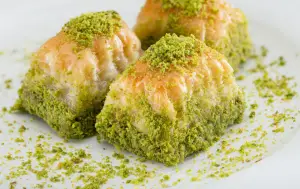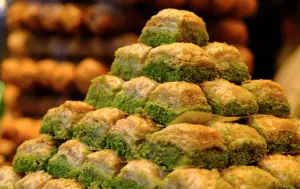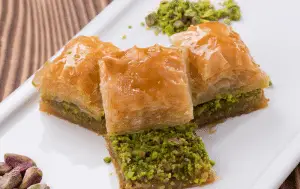Baklava, a celebrated dessert, stands out with its rich history and delightful taste. This sweet pastry captivates taste buds with its layers of thin, flaky phyllo dough, a heart of finely chopped nuts, and a generous soaking in honey or sweet syrup. Originating from the kitchens of ancient empires, baklava has evolved into various forms across different cultures. However, its essence remains the same: a sweet, crunchy, and nutty treat that symbolizes hospitality and celebration.
Brief History and Origin
Tracing Baklava’s history takes us on a journey back to ancient civilizations. Its roots are often debated, with some attributing its origin to the Assyrians in the 8th century B.C., while others point to the Byzantine Empire. Nevertheless, baklava, as we know it today, likely gained prominence in the imperial kitchens of the Topkapi Palace in Constantinople. Over the centuries, it became a ceremonial dessert in the Ottoman Empire, notably offered to the Janissaries during Ramadan in a procession called Baklava Alayı. As the Ottoman Empire expanded, baklava traveled, finding a special place in Middle Eastern, Greek, and Turkish cuisines. Each region infused its own unique twist, reflecting local tastes and traditions.
This brief glimpse into baklava’s history sets the stage for a deeper exploration of its cultural significance, ingredients, and preparation methods in the following sections.
Development in the Ottoman Empire
The evolution of baklava reached a pivotal stage in the Ottoman Empire, where it flourished in the royal kitchens. Historically, baklava was more than just a dessert; it was a symbol of sophistication and opulence. The Ottoman chefs experimented with the recipe, perfecting the delicate layers of phyllo and the balance of sweetness and nuts. Significantly, the Sultan would present baklava to the Janissaries as part of the Baklava Alayı, a ceremonial distribution during Ramadan, showcasing the dessert’s prestige within the empire.
Cultural Significance in Different Regions (Middle East, Greece, Turkey)
As the Ottoman Empire expanded, baklava seamlessly integrated into the culinary traditions of various regions, each adding its own unique flair. In the Middle East, the dessert often features a mixture of pistachios, walnuts, and a hint of rose water, reflecting the region’s penchant for aromatic flavors. Greek baklava, known for its butter-rich layers and cinnamon-infused nut mixture, offers a different taste profile. Turkish baklava, on the other hand, is renowned for its fine, almost paper-thin layers of dough and generous use of pistachios. These variations not only represent the diversity of ingredients available in each region but also signify the adaptability and enduring appeal of baklava across different cultures.
-
- Explore the nuances between fudgy and cakey brownies, perfect for deciding which type to use in your Brownie Bottom Cheesecake.
- Fudgy vs. Cakey Brownies
Role in Traditions and Festivals
Baklava’s role in traditions and festivals is a testament to its cultural significance. In many Middle Eastern and Mediterranean societies, baklava is a staple during celebrations such as weddings, religious festivals, and family gatherings. For instance, during Eid and Ramadan, Muslim families often prepare or buy baklava as a sign of festivity and generosity. Similarly, in Greek and Turkish cultures, it is a customary offering during Christmas and Easter celebrations, symbolizing joy and togetherness. This widespread use of baklava in various celebrations underlines its role as a unifier, bringing people together through the shared experience of enjoying a time-honored delicacy.
In summary, Baklava’s journey through history and its adaptation across different regions underline its significant cultural and historical value. From the royal courts of the Ottoman Empire to the festive tables in homes around the Mediterranean and the Middle East, baklava continues to be a cherished symbol of heritage and communal joy.
Core Ingredients (Phyllo Dough, Nuts, and Honey)
Baklava’s allure largely stems from its simple yet elegant composition. The core ingredients include phyllo dough, nuts, and honey or sweet syrup. Phyllo dough, known for its thin, paper-like layers, is the backbone of the dessert, providing a delicate crunchiness. Nuts, typically walnuts, pistachios, or almonds, are finely chopped and nestled between the phyllo layers, adding rich flavor and texture. Finally, honey or a sweet syrup, often infused with lemon or rosewater, is liberally poured over the baked pastry, imbuing it with a moist, sweet, and slightly tangy essence.
Regional Variations of Baklava
Baklava’s adaptability is evident in its regional variations. The Middle Eastern version often favors a higher ratio of pistachios and may include cardamom or rosewater for an aromatic touch. Greek baklava commonly uses a mix of walnuts and cinnamon with a honey-lemon syrup. In contrast, Turkish baklava is known for its fine layers and generous use of pistachios, often served with kaymak, a creamy dairy product. These regional distinctions not only offer a palette of flavors but also reflect the local ingredients and cultural preferences.
Popular Baklava Flavors and Innovations
Innovation in baklava has led to a range of flavors and styles. Modern interpretations see the inclusion of chocolate, cream-filled layers, or even savory versions incorporating cheeses. Some chefs experiment with less traditional nuts like pecans or macadamias, while others infuse the syrup with contemporary flavors like orange blossom or vanilla. Vegan and gluten-free versions are also emerging, catering to diverse dietary preferences. These innovations reflect baklava’s versatility and its ability to evolve while maintaining its essence as a beloved dessert.
In conclusion, baklava’s charm lies in its simplicity and its capacity for variation. The classic combination of phyllo dough, nuts, and honey remains at its heart, but the regional adaptations and modern innovations ensure that baklava continues to delight palates around the world. Whether sticking to traditional recipes or exploring new variations, baklava remains a testament to culinary creativity and cultural fusion.
-
- Learn how to make no-bake chocolate coconut balls, a simple yet delightful treat that complements any dessert table.
- Chocolate Coconut Balls
Step-by-Step Guide to Making Baklava
Making baklava involves a series of well-coordinated steps. First, gather all ingredients, including phyllo dough, nuts, and syrup. Begin by preheating the oven, then prepare the nut mixture by finely chopping or grinding the nuts with spices. Next, thoroughly butter a baking dish. Unroll the phyllo dough, covering it with a damp cloth to prevent drying. Lay the first layer of phyllo in the dish, brushing it with melted butter. Repeat this process for several layers, then evenly spread a layer of the nut mixture. Continue alternating layers of buttered phyllo and nuts until all ingredients are used, finishing with a top layer of phyllo. Before baking, cut the baklava into diamonds or squares. Bake until golden brown, then immediately pour the pre-prepared syrup over the hot baklava. Allow it to cool, letting the syrup absorb fully.
 Baklava Recipe
Baklava Recipe 
Ingredients:
Phyllo dough: 1 package (about 16 ounces)
Unsalted butter: 1 cup, melted
Nuts: 2 cups finely chopped (walnuts, pistachios, or almonds)
Sugar: 1/3 cup
Ground cinnamon: 1 teaspoon
For the Syrup:
Honey: 1 cup
Sugar: 1 cup
Lemon juice: 2 tablespoons
Water: 3/4 cup
Optional: A stick of cinnamon or a few cloves for extra flavor
Instructions:
Preheat your oven to 350°F (175°C). Grease a 9×13 inch baking dish.
Mix chopped nuts with sugar and ground cinnamon.
Place one sheet of phyllo dough in the dish; brush with melted butter. Repeat until you have 8 layers.
Sprinkle a thin layer of the nut mixture over the dough.
Continue layering phyllo sheets and nut mixture, finishing with about 8 layers of phyllo on top.
Cut the baklava into diamond or square shapes.
Bake for about 50 minutes, or until golden and crisp.
For the Syrup:
In a saucepan, combine honey, sugar, lemon juice, and water (and cinnamon/cloves if using).
Bring to a boil, then reduce heat and simmer for about 10 minutes.
Remove any spices and pour the hot syrup over the cooled baklava.
Enjoy your sweet and crunchy Baklava!
Tips for Handling Phyllo Dough
Phyllo dough is notoriously delicate and dries out quickly. To prevent this, always keep the unused dough covered with a damp towel. Work swiftly when layering and buttering the sheets. If the dough tears, simply patch it up with extra pieces, as it will still bake well. Ensure the dough is completely thawed before use, as frozen or partially thawed phyllo is more prone to tearing.
Common Challenges and Solutions
A common challenge in making baklava is ensuring the pastry is neither too soggy nor too dry. This balance is achieved by correctly preparing the syrup and applying it to the hot baklava right after baking. If the syrup is too thick, it won’t absorb well, leading to dry layers; if it is too thin, the baklava becomes soggy. Another challenge is achieving even layers. This requires patience and a gentle touch when laying and buttering the phyllo. If the top layer browns too quickly in the oven, cover it loosely with foil to prevent burning.
In summary, making baklava requires precision, from preparing the layers to baking and applying syrup. With practice and attention to detail, the process becomes more intuitive, leading to a deliciously layered and flavored dessert.
How to Serve Baklava
When serving baklava, presentation plays a key role. Typically served at room temperature, baklava is best presented on a platter, showcasing its layered beauty. Each piece, often cut into diamonds or squares, can be garnished with finely chopped nuts or a drizzle of honey for an extra touch of elegance. In some traditions, baklava is paired with a cup of strong coffee or tea, balancing its sweetness with a bitter beverage, enhancing the overall gastronomic experience.
Best Practices for Storage and Shelf Life
Storing baklava properly ensures it retains its flavor and texture. Baklava can be kept at room temperature for about 1–2 weeks. It should be covered with a clean tea towel or kept in an airtight container to prevent it from drying out. For longer storage, baklava can be refrigerated for up to three weeks or frozen for up to four months. When freezing, it’s advisable to store baklava in small batches to avoid thawing the entire amount when only a few pieces are needed. Thawing should be done in the refrigerator overnight or at room temperature for a few hours.
In summary, serving baklava in a visually appealing manner enhances the enjoyment, while proper storage is crucial for maintaining its quality over time. Whether enjoyed fresh or stored for later, baklava remains a delightful treat for various occasions.
Caloric and Nutritional Content
Baklava, with its layers of phyllo dough, nuts, and syrup, is a calorie-dense dessert. A typical piece of baklava can contain approximately 200–300 calories, with the majority coming from fats and carbohydrates. The nuts provide protein and healthy fats, while the honey or syrup contributes to the sugar content. Each ingredient adds not only flavor but also nutritional value. For example, nuts like walnuts or pistachios are rich in omega-3 fatty acids, while honey offers trace amounts of vitamins and antioxidants.
Considerations for Health-Conscious Consumers
For health-conscious consumers, enjoying baklava in moderation is key. Given its high sugar and fat content, it is best consumed as an occasional treat rather than a regular part of the diet. Those looking to reduce their sugar intake can experiment with less syrup or use alternatives like agave. Similarly, using less butter or opting for a vegan butter alternative can lower the fat content. It’s also possible to find or make reduced-sugar and gluten-free versions of baklava, catering to specific dietary needs without compromising on taste.
In summary, while baklava is a delicious and indulgent dessert, being aware of its caloric and nutritional content helps in making informed choices. Enjoying it in moderation allows one to savor this traditional sweet without overindulgence.
-
- This is a great read for those looking for a healthy and convenient breakfast recipe that offers the comforting flavors of apple pie.
- Apple Pie Overnight Oats
FAQs
Can baklava be frozen?
Yes, baklava can indeed be frozen. To do so effectively, wrap it tightly in plastic wrap or aluminum foil, and then place it in an airtight container or freezer bag. Baklava can be stored in the freezer for up to four months. When you’re ready to enjoy it, thaw it at room temperature or in the refrigerator overnight. Freezing does not significantly affect its taste or texture.
How do I prevent sogginess?
To prevent baklava from becoming soggy, the key lies in the syrup. Make sure the syrup is hot when poured over the freshly baked, warm baklava. This technique allows the syrup to be absorbed properly, keeping the layers crisp. Additionally, avoid covering the baklava while it cools, as trapped steam can lead to sogginess.
Can different nuts be used?
Absolutely! While traditional recipes often call for walnuts, pistachios, or almonds, you can experiment with different nuts according to your taste preferences. Pecans, hazelnuts, and even macadamias are excellent choices. Each type of nut will impart its own unique flavor and texture to the baklava.
Is Baklava Gluten-Free?
Traditional baklava is not gluten-free, as it is made with phyllo dough, which contains wheat. However, gluten-free versions of baklava can be made using gluten-free phyllo dough or alternative ingredients that mimic the texture of phyllo. These gluten-free options are becoming more available in specialty food stores or can be made at home.
Conclusion
In conclusion, baklava, a rich and layered dessert, is not only a treat for the palate but also a testament to the rich culinary history of the Middle East, Greece, and Turkey. Its delicate layers of phyllo dough, combined with a variety of nuts and sweet syrup, offer a unique and indulgent experience. While preparing baklava might seem daunting, understanding the proper techniques and tips can make it an enjoyable and rewarding process. Moreover, its flexibility in terms of ingredients and adaptations allows it to cater to diverse tastes and dietary preferences. Whether enjoyed as a festive treat or a luxurious indulgence, baklava remains a beloved dessert across many cultures.

Baklava
- Author: recipstep
- Total Time: 1 hour 20 minutes
- Yield: 24 servings
- Diet: Vegetarian
Description
Baklava is a rich, sweet pastry made of layers of filo dough filled with chopped nuts and sweetened with syrup or honey. It’s a celebrated dessert in Middle Eastern and Mediterranean cuisines, known for its flaky texture and indulgent taste.
Ingredients
Phyllo dough: 1 package (about 16 ounces)
Unsalted butter: 1 cup, melted
Nuts: 2 cups finely chopped (walnuts, pistachios, or almonds)
Sugar: 1/3 cup
Ground cinnamon: 1 teaspoon
For the Syrup:
Honey: 1 cup
Sugar: 1 cup
Lemon juice: 2 tablespoons
Water: 3/4 cup
Optional: A stick of cinnamon or a few cloves for extra flavor
Instructions
Preheat your oven to 350°F (175°C). Grease a 9×13 inch baking dish.
Mix chopped nuts with sugar and ground cinnamon.
Place one sheet of phyllo dough in the dish; brush with melted butter. Repeat until you have 8 layers.
Sprinkle a thin layer of the nut mixture over the dough.
Continue layering phyllo sheets and nut mixture, finishing with about 8 layers of phyllo on top.
Cut the baklava into diamond or square shapes.
Bake for about 50 minutes, or until golden and crisp.
For the Syrup:
In a saucepan, combine honey, sugar, lemon juice, and water (and cinnamon/cloves if using).
Bring to a boil, then reduce heat and simmer for about 10 minutes.
Remove any spices and pour the hot syrup over the cooled baklava.
Enjoy your sweet and crunchy Baklava!
Notes
- Work quickly with filo dough as it dries out fast. Keep unused sheets covered with a damp towel.
- Cutting the baklava before baking allows the syrup to seep into the layers, making it more flavorful.
- Allow the baklava to fully absorb the syrup and cool down to enhance its texture and taste.
- Prep Time: 30 minutes
- Cook Time: 50 minutes
- Category: Dessert
- Method: Baking
- Cuisine: Middle Eastern, Mediterranean
Nutrition
- Calories: 300
- Sugar: 20g
- Sodium: 160mg
- Fat: 18g
- Carbohydrates: 34g
- Fiber: 2g
- Protein: 4g





